Tap Maize Yield Productivity in China: A Meta-Analysis of Agronomic Measures and Planting Density Optimization
Abstract
:1. Introduction
2. Materials and Methods
2.1. Data Collection and Preparation
2.2. Data Analysis
3. Results
3.1. Effect of Agronomic Strategies on Planting Density and Yield in Different Regions of China
3.1.1. Regional Variations in Maize Yield and Planting Density Under Different Agronomic Strategies
3.1.2. Effect Sizes of Agronomic Strategies on Regional Maize Planting Density and Yield
3.2. Effect of Different Types of Agronomic Measures on OPD and OPD Yield of Maize
3.3. Effect of Agronomic Measures on OPD and OPD Yield of Maize in Different Regions
3.3.1. Effect of Agronomic Measures on OPD of Maize in Different Regions
3.3.2. Effect of Agronomic Measures on OPD Yield of Maize in Different Regions
4. Discussion
4.1. Yield Gains Achieved Through Increased Planting Density
4.2. Application of Agronomic Measures Further Taps OPD and Yield Potential
4.3. Regional Effectiveness of Agronomic Measures
4.4. Study Limitations and Future Research Perspectives
5. Conclusions
Supplementary Materials
Author Contributions
Funding
Data Availability Statement
Acknowledgments
Conflicts of Interest
References
- van Dijk, M.; Morley, T.; Rau, M.L.; Saghai, Y. A Meta-Analysis of Projected Global Food Demand and Population at Risk of Hunger for the Period 2010–2050. Nat. Food 2021, 2, 494–501. [Google Scholar] [CrossRef] [PubMed]
- Ray, D.K.; Ramankutty, N.; Mueller, N.D.; West, P.C.; Foley, J.A. Recent Patterns of Crop Yield Growth and Stagnation. Nat. Commun. 2012, 3, 1293. [Google Scholar] [CrossRef] [PubMed]
- Wang, Z.; Yin, Y.; Wang, Y.; Tian, X.; Ying, H.; Zhang, Q.; Xue, Y.; Oenema, O.; Li, S.; Zhou, F.; et al. Integrating Crop Redistribution and Improved Management Towards Meeting China’s Food Demand with Lower Environmental Costs. Nat. Food 2022, 3, 1031–1039. [Google Scholar] [CrossRef]
- Huang, T.; Döring, T.F.; Zhao, X.; Weiner, J.; Dang, P.; Zhang, M.; Zhang, M.; Siddique, K.H.M.; Schmid, B.; Qin, X. Cultivar Mixtures Increase Crop Yields and Temporal Yield Stability Globally. A Meta-Analysis. Agron. Sustain. Dev. 2024, 44, 28. [Google Scholar] [CrossRef]
- Yang, X.; Xiong, J.; Du, T.; Ju, X.; Gan, Y.; Li, S.; Xia, L.; Shen, Y.; Pacenka, S.; Steenhuis, T.S.; et al. Diversifying Crop Rotation Increases Food Production, Reduces Net Greenhouse Gas Emissions and Improves Soil Health. Nat. Commun. 2024, 15, 198. [Google Scholar] [CrossRef]
- Han, X.; Chen, Y.; Wang, X. Impacts of China’s Bioethanol Policy on the Global Maize Market: A Partial Equilibrium Analysis to 2030. Food Secur. 2022, 14, 147–163. [Google Scholar] [CrossRef] [PubMed]
- FAO. World Food and Agriculture—Statistical Yearbook 2020; FAO: Rome, Italy, 2020. [Google Scholar]
- NBSC. National Bureau of Statistics of China-China Statistical Yearbook; China Statistics Press: Beijing, China, 2022. [Google Scholar]
- Lu, W.; Chen, N.; Qian, W.-X. Modeling the Effects of Urbanization on Grain Production and Consumption in China. J. Integr. Agric. 2017, 16, 1393–1405. [Google Scholar] [CrossRef]
- OECD/FAO. Oecd-Fao Agricultural Outlook 2021–2030; OECD Publishing: Paris, France, 2021. [Google Scholar] [CrossRef]
- Zhang, L.; Zhang, Z.; Luo, Y.; Cao, J.; Li, Z. Optimizing Genotype-Environment-Management Interactions for Maize Farmers to Adapt to Climate Change in Different Agro-Ecological Zones across China. Sci. Total Environ. 2020, 728, 138614. [Google Scholar] [CrossRef]
- Cooper, M.; Messina, C.D.; Tang, T.; Gho, C.; Powell, O.M.; Podlich, D.W.; Technow, F.; Hammer, G.L. Predicting Genotype × Environment × Management (G × E × M) Interactions for the Design of Crop Improvement Strategies. Plant Breed. Rev. 2022, 46, 467–585. [Google Scholar] [CrossRef]
- Grassini, P.; Specht, J.E.; Tollenaar, M.; Ciampitti, I.; Cassman, K.G. Chapter 2—High-Yield Maize–Soybean Cropping Systems in the Us Corn Belt. In Crop Physiology, 2nd ed.; Sadras, V.O., Calderini, D.F., Eds.; Academic Press: San Diego, CA, USA, 2015; pp. 17–41. [Google Scholar] [CrossRef]
- Rizzo, G.; Monzon, J.P.; Tenorio, F.A.; Howard, R.; Cassman, K.G.; Grassini, P. Climate and Agronomy, Not Genetics, Underpin Recent Maize Yield Gains in Favorable Environments. Proc. Natl. Acad. Sci. USA 2022, 119, e2113629119. [Google Scholar] [CrossRef]
- Duvick, D.N. The Contribution of Breeding to Yield Advances in Maize (Zea mays L.). Adv. Agron. 2005, 86, 83–145. [Google Scholar] [CrossRef]
- Xu, W.; Liu, C.; Wang, K.; Xie, R.; Ming, B.; Wang, Y.; Zhang, G.; Liu, G.; Zhao, R.; Fan, P.; et al. Adjusting Maize Plant Density to Different Climatic Conditions across a Large Longitudinal Distance in China. Field Crops Res. 2017, 212, 126–134. [Google Scholar] [CrossRef]
- Luo, N.; Meng, Q.; Feng, P.; Qu, Z.; Yu, Y.; Liu, D.L.; Müller, C.; Wang, P. China Can Be Self-Sufficient in Maize Production by 2030 with Optimal Crop Management. Nat. Commun. 2023, 14, 2637. [Google Scholar] [CrossRef] [PubMed]
- Testa, G.; Reyneri, A.; Blandino, M. Maize Grain Yield Enhancement through High Plant Density Cultivation with Different Inter-Row and Intra-Row Spacings. Eur. J. Agron. 2016, 72, 28–37. [Google Scholar] [CrossRef]
- Ming, B.; Xie, R.; Hou, P.; Li, L.; Wang, K.; Li, S. Changes of Maize Planting Density in China. Sci. Agric. Sin. 2017, 50, 1960–1972. (In Chinese) [Google Scholar] [CrossRef]
- Dias, F.S.; Rezende, W.M.; Zuffo, L.T.; Caixeta, D.G.; Massensini, M.A.; Ribeiro Junior, J.I.; DeLima, R.O. Agronomic Responses of Maize Hybrids to Row Spacing and Plant Population in the Summer and Winter Seasons in Brazil. Agron. J. 2019, 111, 3119–3129. [Google Scholar] [CrossRef]
- Liang, W.; Carberry, P.; Wang, G.; Lü, R.; Lü, H.; Xia, A. Quantifying the Yield Gap in Wheat–Maize Cropping Systems of the Hebei Plain, China. Field Crops Res. 2011, 124, 180–185. [Google Scholar] [CrossRef]
- Wang, J.; Wang, E.; Yang, X.; Zhang, F.; Yin, H. Increased Yield Potential of Wheat-Maize Cropping System in the North China Plain by Climate Change Adaptation. Clim. Change 2012, 113, 825–840. [Google Scholar] [CrossRef]
- Aramburu-Merlos, F.; Tenorio, F.A.M.; Mashingaidze, N.; Sananka, A.; Aston, S.; Ojeda, J.J.; Grassini, P. Adopting Yield-Improving Practices to Meet Maize Demand in Sub-Saharan Africa without Cropland Expansion. Nat. Commun. 2024, 15, 4492. [Google Scholar] [CrossRef]
- Oluoch, K.O.a.; De Groote, H.; Gitonga, Z.M.; Jin, Z.; Davis, K.F. A Suite of Agronomic Factors Can Offset the Effects of Climate Variability on Rainfed Maize Production in Kenya. Sci. Rep. 2022, 12, 16043. [Google Scholar] [CrossRef]
- Shi, R.; Wang, J.; Tong, L.; Du, T.; Shukla, M.K.; Jiang, X.; Li, D.; Qin, Y.; He, L.; Bai, X.; et al. Optimizing Planting Density and Irrigation Depth of Hybrid Maize Seed Production under Limited Water Availability. Agric. Water Manag. 2022, 271, 107759. [Google Scholar] [CrossRef]
- Zhang, Q.; Zhang, L.; Evers, J.; van der Werf, W.; Zhang, W.; Duan, L. Maize Yield and Quality in Response to Plant Density and Application of a Novel Plant Growth Regulator. Field Crops Res. 2014, 164, 82–89. [Google Scholar] [CrossRef]
- Zhou, B.; Sun, X.; Wang, D.; Ding, Z.; Li, C.; Ma, W.; Zhao, M. Integrated Agronomic Practice Increases Maize Grain Yield and Nitrogen Use Efficiency under Various Soil Fertility Conditions. Crop J. 2019, 7, 527–538. [Google Scholar] [CrossRef]
- Andrade, F.H.; Uhart, S.A.; Cirilo, A. Temperature Affects Radiation Use Efficiency in Maize. Field Crops Res. 1993, 32, 17–25. [Google Scholar] [CrossRef]
- Cassman, K.G.; Dobermann, A.; Walters, D.T.; Yang, H. Meeting Cereal Demand While Protecting Natural Resources and Improving Environmental Quality. Annu. Rev. Environ. Resour. 2003, 28, 315–358. [Google Scholar] [CrossRef]
- Fan, M.; Shen, J.; Yuan, L.; Jiang, R.; Chen, X.; Davies, W.J.; Zhang, F. Improving Crop Productivity and Resource Use Efficiency to Ensure Food Security and Environmental Quality in China. J. Exp. Bot. 2012, 63, 13–24. [Google Scholar] [CrossRef]
- Shah, F.; Wu, W. Soil and Crop Management Strategies to Ensure Higher Crop Productivity within Sustainable Environments. Sustainability 2019, 11, 1485. [Google Scholar] [CrossRef]
- Assefa, Y.; Carter, P.; Hinds, M.; Bhalla, G.; Schon, R.; Jeschke, M.; Paszkiewicz, S.; Smith, S.; Ciampitti, I.A. Analysis of Long Term Study Indicates Both Agronomic Optimal Plant Density and Increase Maize Yield Per Plant Contributed to Yield Gain. Sci. Rep. 2018, 8, 4937. [Google Scholar] [CrossRef]
- Qin, X.; Feng, F.; Li, Y.; Xu, S.; Siddique, K.H.M.; Liao, Y. Maize Yield Improvements in China: Past Trends and Future Directions. Plant Breed. 2016, 135, 166–176. [Google Scholar] [CrossRef]
- Venkataanusha, P.; Anuradha, C.; Murty, D.; Chebrolu, S. Detecting Outliers in High Dimensional Data Sets Using Z-Score Methodology. Int. J. Innov. Technol. Explor. Eng. 2019, 9, 48–53. [Google Scholar] [CrossRef]
- Dallah, D.; Sulieman, H. Outlier Detection Using the Range Distribution. In Advances in Mathematical Modeling and Scientific Computing; Kamalov, F., Sivaraj, R., Leung, H.-H., Eds.; Birkhäuser: Cham, Switzerland, 2024. [Google Scholar] [CrossRef]
- Burrough, P.A.; McDonnell, R.A. Principle of Geographic Information Systems; Oxford University Press: New York, NY, USA, 1998; Available online: https://www.researchgate.net/publication/37419765 (accessed on 13 September 2024).
- Hedges, L.V.; Gurevitch, J.; Curtis, P.S. The Meta-Analysis of Response Ratios in Experimental Ecology. Ecology 1999, 80, 1150–1156. [Google Scholar] [CrossRef]
- Luo, Y.; Hui, D.; Zhang, D. Elevated CO2 Stimulates Net Accumulations of Carbon and Nitrogen in Land Ecosystems: A Meta-Analysis. Ecology 2006, 87, 53–63. [Google Scholar] [CrossRef]
- Teixeira, E.I.; George, M.; Herreman, T.; Brown, H.; Fletcher, A.; Chakwizira, E.; de Ruiter, J.; Maley, S.; Noble, A. The Impact of Water and Nitrogen Limitation on Maize Biomass and Resource-Use Efficiencies for Radiation, Water and Nitrogen. Field Crops Res. 2014, 168, 109–118. [Google Scholar] [CrossRef]
- Wang, Y.; Zhang, G.; Li, R.; Wang, K.; Ming, B.; Hou, P.; Xie, R.; Xue, J.; Li, S. Pathways to Increase Maize Yield in Northwest China: A Multi-Year, Multi-Variety Analysis. Eur. J. Agron. 2023, 149, 126892. [Google Scholar] [CrossRef]
- Shen, D.; Wang, K.; Zhou, L.; Fang, L.; Wang, Z.; Fu, J.; Zhang, T.; Liang, Z.; Xie, R.; Ming, B.; et al. Increasing Planting Density and Optimizing Irrigation to Improve Maize Yield and Water-Use Efficiency in Northeast China. Agronomy 2024, 14, 400. [Google Scholar] [CrossRef]
- Li, Y.; Ming, B.; Fan, P.; Liu, Y.; Wang, K.; Hou, P.; Xue, J.; Li, S.; Xie, R. Quantifying Contributions of Leaf Area and Longevity to Leaf Area Duration under Increased Planting Density and Nitrogen Input Regimens During Maize Yield Improvement. Field Crops Res. 2022, 283, 108551. [Google Scholar] [CrossRef]
- Liu, G.; Liu, W.; Hou, P.; Ming, B.; Yang, Y.; Guo, X.; Xie, R.; Wang, K.; Li, S. Reducing Maize Yield Gap by Matching Plant Density and Solar Radiation. J. Integr. Agric. 2021, 20, 363–370. [Google Scholar] [CrossRef]
- Tokatlidis, I.S.; Has, V.; Melidis, V.; Has, I.; Mylonas, I.; Evgenidis, G.; Copandean, A.; Ninou, E.; Fasoula, V.A. Maize Hybrids Less Dependent on High Plant Densities Improve Resource-Use Efficiency in Rainfed and Irrigated Conditions. Field Crops Res. 2011, 120, 345–351. [Google Scholar] [CrossRef]
- Tian, J.; Wang, C.; Xia, J.; Wu, L.; Xu, G.; Wu, W.; Li, D.; Qin, W.; Han, X.; Chen, Q.; et al. Teosinte Ligule Allele Narrows Plant Architecture and Enhances High-Density Maize Yields. Science 2019, 365, 658–664. [Google Scholar] [CrossRef]
- Jafari, F.; Wang, B.; Wang, H.; Zou, J. Breeding Maize of Ideal Plant Architecture for High-Density Planting Tolerance through Modulating Shade Avoidance Response and Beyond. J. Integr. Plant Biol. 2024, 66, 849–864. [Google Scholar] [CrossRef]
- Tian, J.; Wang, C.; Chen, F.; Qin, W.; Yang, H.; Zhao, S.; Xia, J.; Du, X.; Zhu, Y.; Wu, L.; et al. Maize Smart-Canopy Architecture Enhances Yield at High Densities. Nature 2024, 632, 576–584. [Google Scholar] [CrossRef]
- Luo, N.; Wang, X.; Hou, J.; Wang, Y.; Wang, P.; Meng, Q. Agronomic Optimal Plant Density for Yield Improvement in the Major Maize Regions of China. Crop Sci. 2020, 60, 1580–1590. [Google Scholar] [CrossRef]
- Zhang, G.; Cui, C.; Lv, Y.; Wang, X.; Wang, X.; Zhao, D.; Hu, F.; Wen, X.; Han, J.; Liao, Y. Is It Necessary to Increase the Maize Planting Density in China? Eur. J. Agron. 2024, 159, 127235. [Google Scholar] [CrossRef]
- Zhang, W.; Cao, G.; Li, X.; Zhang, H.; Wang, C.; Liu, Q.; Chen, X.; Cui, Z.; Shen, J.; Jiang, R.; et al. Closing Yield Gaps in China by Empowering Smallholder Farmers. Nature 2016, 537, 671–674. [Google Scholar] [CrossRef]
- Cai, S.; Zhao, X.; Pittelkow, C.M.; Fan, M.; Zhang, X.; Yan, X. Optimal Nitrogen Rate Strategy for Sustainable Rice Production in China. Nature 2023, 615, 73–79. [Google Scholar] [CrossRef]
- Lopez, R.A.; He, X.; De Falcis, E. What Drives China’s New Agricultural Subsidies? World Dev. 2017, 93, 279–292. [Google Scholar] [CrossRef]
- Liu, X.; Gu, W.; Li, C.; Li, J.; Wei, S. Effects of Nitrogen Fertilizer and Chemical Regulation on Spring Maize Lodging Characteristics, Grain Filling and Yield Formation under High Planting Density in Heilongjiang Province, China. J. Integr. Agric. 2021, 20, 511–526. [Google Scholar] [CrossRef]
- Li, R.; Zheng, J.; Xie, R.; Ming, B.; Peng, X.; Luo, Y.; Zheng, H.; Sui, P.; Wang, K.; Hou, P.; et al. Potential Mechanisms of Maize Yield Reduction under Short-Term No-Tillage Combined with Residue Coverage in the Semi-Humid Region of Northeast China. Soil Tillage Res. 2022, 217, 105289. [Google Scholar] [CrossRef]
- Wang, L.; Guo, H.; Wang, L.; Cheng, D. Suitable Tillage Depth Promotes Maize Yields by Changing Soil Physical and Chemical Properties in a 3-Year Experiment in the North China Plain. Sustainability 2022, 14, 15134. [Google Scholar] [CrossRef]
- Shen, H.; Wang, Y.; Fan, X.; Wang, H.; Li, Y. Effects of the Factors on Maize Yield under Drip Irrigation under Film. In Computer and Computing Technologies in Agriculture XI, 11th IFIP WG 5.14 International Conference, CCTA 2017, Jilin, China, 12–15 August 2017; Li, D., Zhao, C., Eds.; Springer: Cham, Switzerland, 2019. [Google Scholar] [CrossRef]
- Zhang, G.; Shen, D.; Ming, B.; Xie, R.; Hou, P.; Xue, J.; Wang, K.; Li, S. Optimizing Planting Density to Increase Maize Yield and Water Use Efficiency and Economic Return in the Arid Region of Northwest China. Agriculture 2022, 12, 1322. [Google Scholar] [CrossRef]
- Shi, L.; Wang, Q.; Zhang, G.; Li, S.; Xue, J. Increasing Maize Production and Advancing Rational Water Allocation and Usage Based on the Optimal Planting Density and Irrigation Levels in Northwest China. Water 2023, 15, 529. [Google Scholar] [CrossRef]
- Orfanou, A.; Pavlou, D.; Porter, W.M. Maize Yield and Irrigation Applied in Conservation and Conventional Tillage at Various Plant Densities. Water 2019, 11, 1726. [Google Scholar] [CrossRef]
- Anderson, E.L. No-Till Effects on Yield and Plant Density of Maize Hybrids. Agron. J. 1986, 78, 323–326. [Google Scholar] [CrossRef]
- Yu, X.; Qu, J.; Hu, S.; Xu, P.; Chen, Z.; Gao, J.; Ma, D. The Effect of Tillage Methods on Soil Physical Properties and Maize Yield in Eastern Inner Mongolia. Eur. J. Agron. 2023, 147, 126852. [Google Scholar] [CrossRef]
- Yang, C.-J.; Zhang, C.; Lu, Y.-N.; Jin, J.-Q.; Wang, X.-L. The Mechanisms of Brassinosteroids’ Action: From Signal Transduction to Plant Development. Mol. Plant 2011, 4, 588–600. [Google Scholar] [CrossRef]
- Chai, M.; Li, Z.; Qin, D.; Liu, Y.; Xu, M.; Dong, L.; Zhang, Q.; Yang, D.; Zhang, P. Effect of Ethephon on Lodging Resistance of Maize Stem. J. Maize Sci. 2017, 25, 63–72. Available online: https://www.doi.org/10.13597/j.cnki.maize.science.20170611 (accessed on 14 October 2024). (In Chinese).
- Manga-Robles, A.; Santiago, R.; Malvar, R.A.; Moreno-González, V.; Fornalé, S.; López, I.; Centeno, M.L.; Acebes, J.L.; Álvarez, J.M.; Caparros-Ruiz, D.; et al. Elucidating Compositional Factors of Maize Cell Walls Contributing to Stalk Strength and Lodging Resistance. Plant Sci. 2021, 307, 110882. [Google Scholar] [CrossRef] [PubMed]
- Geng, W.; Sun, Z.; Ren, B.; Ren, H.; Zhao, B.; Liu, P.; Zhang, J. Spraying Ethephon Effectively Increased Canopy Light Transmittance of Densely Planted Summer Maize, Thus Achieving Synergistic Improvement in Stalk Lodging Resistance and Grain Yield. Plants 2022, 11, 2219. [Google Scholar] [CrossRef]
- Gersani, M.; Brown, J.S.; O’Brien, E.E.; Maina, G.M.; Abramsky, Z. Tragedy of the Commons as a Result of Root Competition. J. Ecol. 2001, 89, 660–669. [Google Scholar] [CrossRef]
- Sharratt, B.S.; McWilliams, D.A. Microclimatic and Rooting Characteristics of Narrow-Row Versus Conventional-Row Corn. Agron. J. 2005, 97, 1129–1135. [Google Scholar] [CrossRef]
- Gao, J.; Lei, M.; Yang, L.; Wang, P.; Tao, H.; Huang, S. Reduced Row Spacing Improved Yield by Optimizing Root Distribution in Maize. Eur. J. Agron. 2021, 127, 126291. [Google Scholar] [CrossRef]
- Jin, R.; Li, Z.; Wang, X.; Liu, F.; Kong, F.; Liu, Q.; Lan, T.; Feng, D.; Yuan, J. Optimizing Row Spacing Increases Stalk Lodging Resistance by Improving Light Distribution in Dense Maize Populations. Agronomy 2023, 13, 462. [Google Scholar] [CrossRef]
- Li, F.; Wang, P.; Wang, J.; Xu, J. Effects of Irrigation before Sowing and Plastic Film Mulching on Yield and Water Uptake of Spring Wheat in Semiarid Loess Plateau of China. Agric. Water Manag. 2004, 67, 77–88. [Google Scholar] [CrossRef]
- Zhao, H.; Wang, R.; Ma, B.; Xiong, Y.; Qiang, S.; Wang, C.; Liu, C.; Li, F. Ridge-Furrow with Full Plastic Film Mulching Improves Water Use Efficiency and Tuber Yields of Potato in a Semiarid Rainfed Ecosystem. Field Crops Res. 2014, 161, 137–148. [Google Scholar] [CrossRef]
- Niu, L.; Yan, Y.; Hou, P.; Bai, W.; Zhao, R.; Wang, Y.; Li, S.; Du, T.; Zhao, M.; Song, J.; et al. Influence of Plastic Film Mulching and Planting Density on Yield, Leaf Anatomy, and Root Characteristics of Maize on the Loess Plateau. Crop J. 2020, 8, 548–564. [Google Scholar] [CrossRef]
- Shi, Y.; Wu, W.; Meng, F.; Zhang, Z.; Zheng, L.; Wang, D. Integrated Management Practices Significantly Affect N2O Emissions and Wheat–Maize Production at Field Scale in the North China Plain. Nutr. Cycl. Agroecosyst. 2013, 95, 203–218. [Google Scholar] [CrossRef]
- Wang, Z.; Gao, J.; Ma, B.L. Concurrent Improvement in Maize Yield and Nitrogen Use Efficiency with Integrated Agronomic Management Strategies. Agron. J. 2014, 106, 1243–1250. [Google Scholar] [CrossRef]
- Yan, P.; Pan, J.; Zhang, W.; Shi, J.; Chen, X.; Cui, Z. A High Plant Density Reduces the Ability of Maize to Use Soil Nitrogen. PLoS ONE 2017, 12, e0172717. [Google Scholar] [CrossRef]
- Hu, X.; Shi, L.; Zeng, J.; Yang, J.; Zha, Y.; Yao, Y.; Cao, G. Estimation of Actual Irrigation Amount and Its Impact on Groundwater Depletion: A Case Study in the Hebei Plain, China. J. Hydrol. 2016, 543, 433–449. [Google Scholar] [CrossRef]
- Zhang, X.; Kong, Y.; Lv, Y.; Yao, F.; Cao, Y.; Shao, X.; Geng, Y.; Wang, L.; Wang, Y. Increased Topsoil Depth Required to Support Increased Grain Yield Production in High Density Maize. Field Crops Res. 2024, 308, 109282. [Google Scholar] [CrossRef]
- Jiang, P.; Li, L.; Xu, D.; Wang, R.; Sun, Q. Response of Maize Growth and Soil Biological Characteristics to Planting Density under Fertigation in a Semi-Arid Region. Int. J. Agric. Biol. Eng. 2024, 17, 186–192. [Google Scholar] [CrossRef]
- Du, X.; Wang, Z.; Lei, W.; Kong, L. Increased Planting Density Combined with Reduced Nitrogen Rate to Achieve High Yield in Maize. Sci. Rep. 2021, 11, 358. [Google Scholar] [CrossRef]
- Zhang, S.; Chen, X.; Jia, S.; Liang, A.; Zhang, X.; Yang, X.; Wei, S.; Sun, B.; Huang, D.; Zhou, G. The Potential Mechanism of Long-Term Conservation Tillage Effects on Maize Yield in the Black Soil of Northeast China. Soil Tillage Res. 2015, 154, 84–90. [Google Scholar] [CrossRef]
- Li, B.; Liu, Z.; Huang, F.; Yang, X.; Liu, Z.; Wan, W.; Wang, J.; Xu, Y.; Li, Z.; Ren, T. Ensuring National Food Security by Strengthening High-Productivity Black Soil Granary in Northeast China. Bull. Chin. Acad. Sci. 2021, 36, 1184–1193. (In Chinese) [Google Scholar] [CrossRef]
- Chen, K.; Chen, Y.; Long, H.; Li, N. How Does Land Consolidation Affect Rural Development Transformation? J. Geogr. Sci 2024, 34, 417–438. [Google Scholar] [CrossRef]
- Jiang, X.; Tong, L.; Kang, S.; Li, F.; Li, D.; Qin, Y.; Shi, R.; Li, J. Planting Density Affected Biomass and Grain Yield of Maize for Seed Production in an Arid Region of Northwest China. J. Arid Land 2018, 10, 292–303. [Google Scholar] [CrossRef]
- Lu, Y.; Jiang, S.; Ren, L.; Zhang, L.; Wang, M.; Liu, R.; Wei, L. Spatial and Temporal Variability in Precipitation Concentration over Mainland China, 1961–2017. Water 2019, 11, 881. [Google Scholar] [CrossRef]
- Tiwari, T.P.; Brook, R.M.; Sinclair, F.L. Implications of Hill Farmers’ Agronomic Practices in Nepal for Crop Improvement in Maize. Exp. Agric. 2004, 40, 397–417. [Google Scholar] [CrossRef]
- Liu, D.; Song, C.; Xin, Z.; Fang, C.; Liu, Z. Spatial Patterns and Driving Factor Analysis of Recommended Nitrogen Application Rate for the Trade-Off between Economy and Environment for Maize in China. J. Environ. Manag. 2022, 322, 116099. [Google Scholar] [CrossRef]

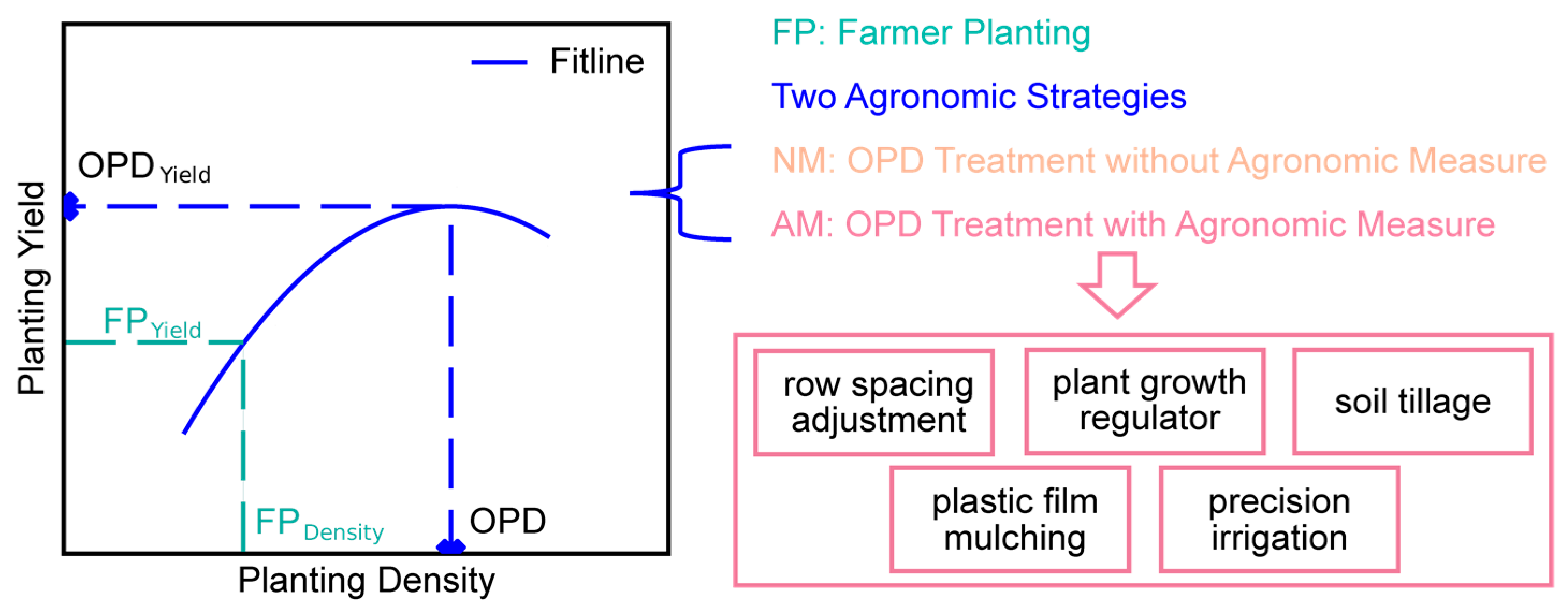

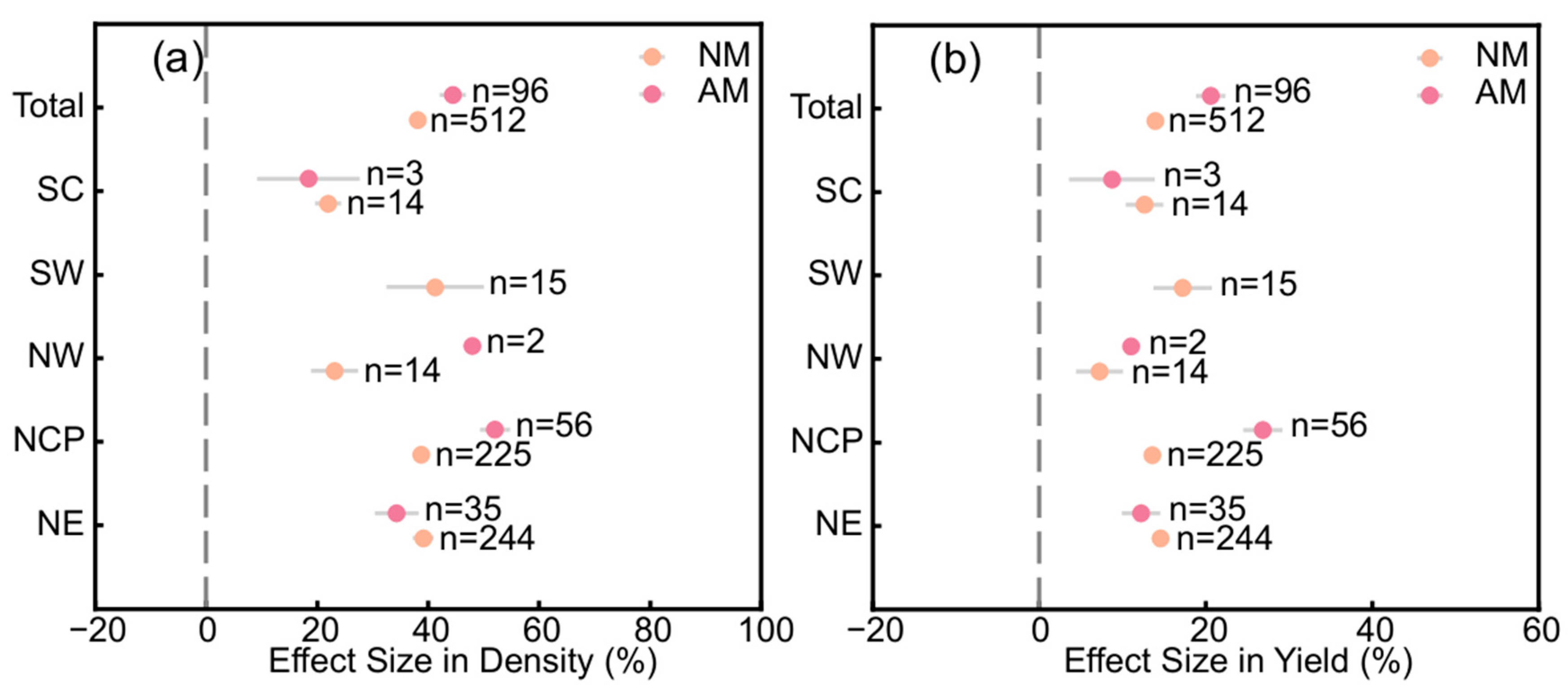
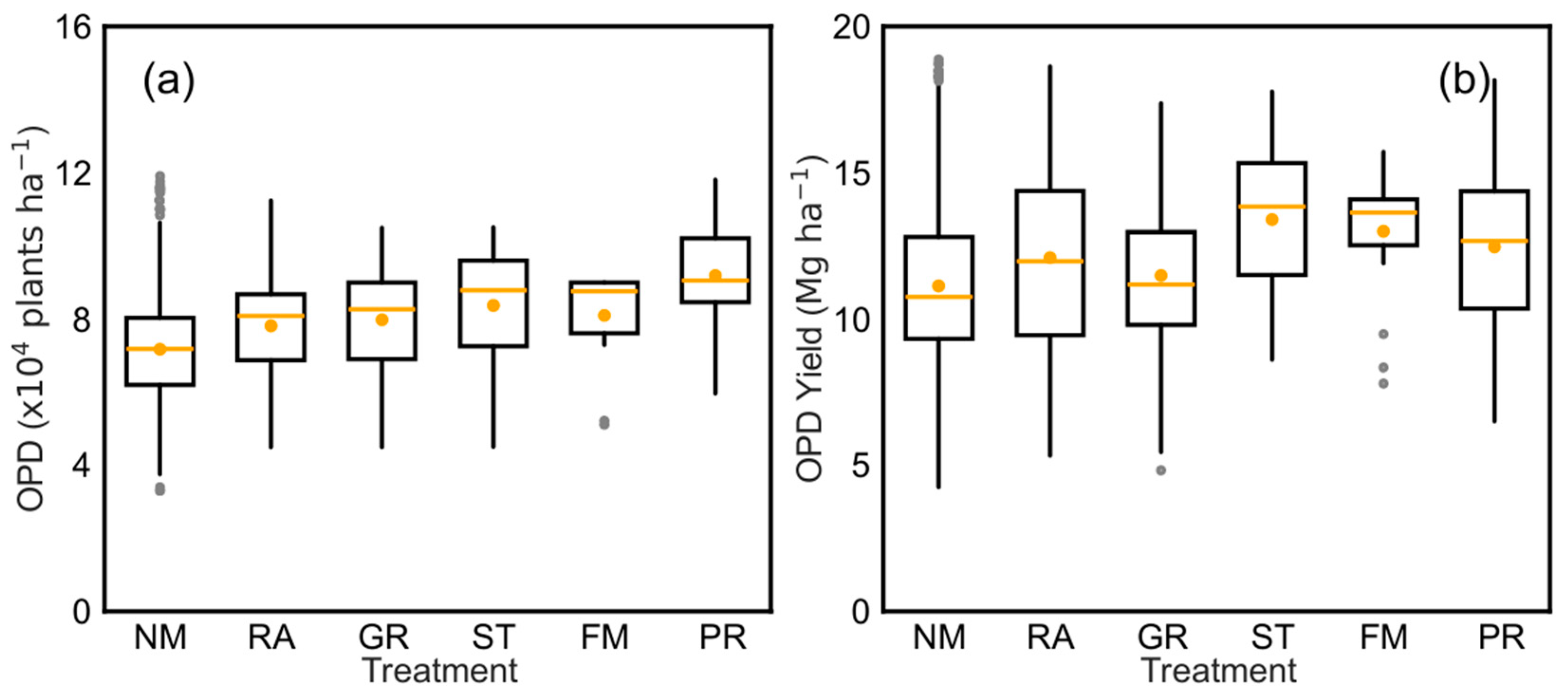
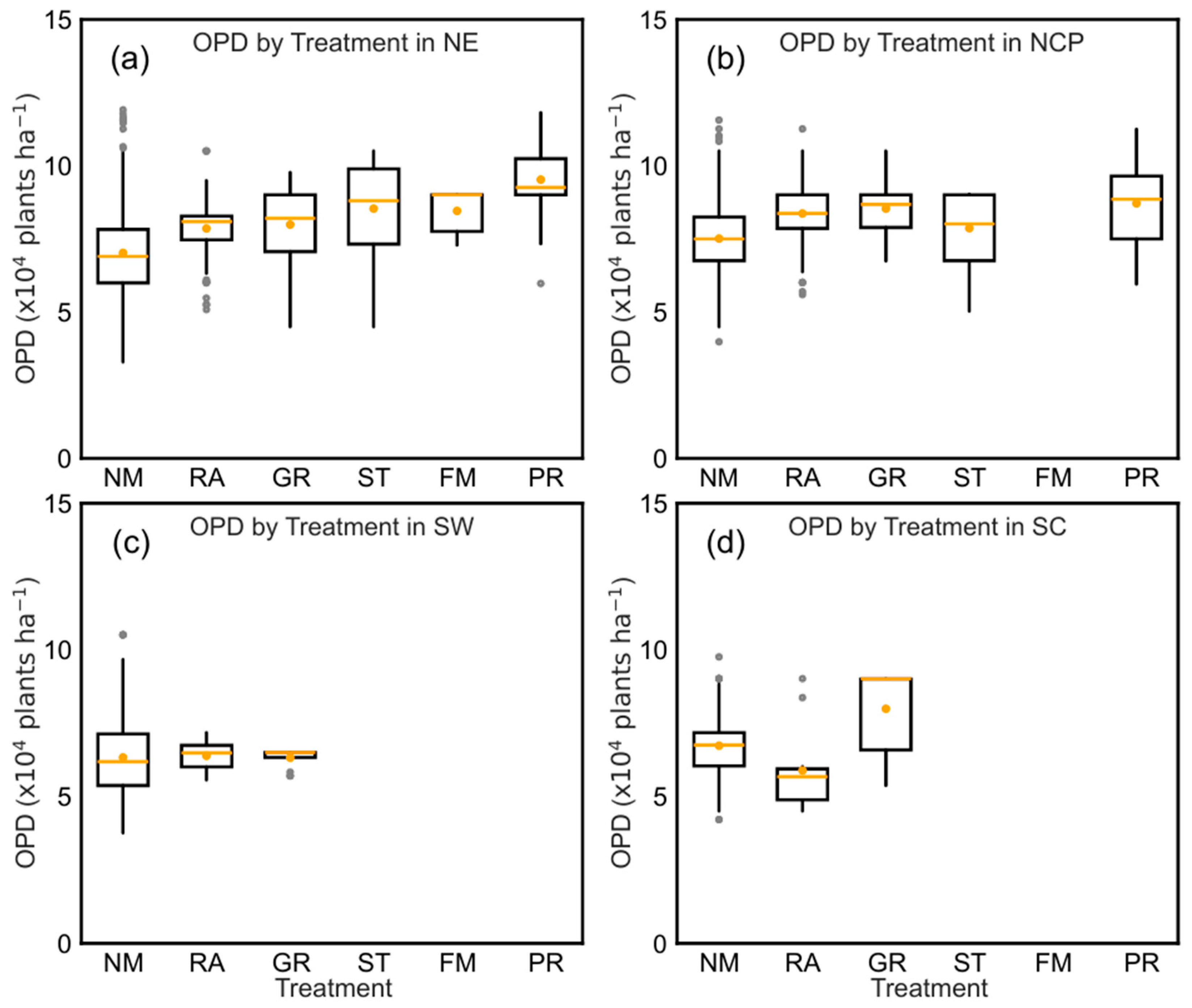
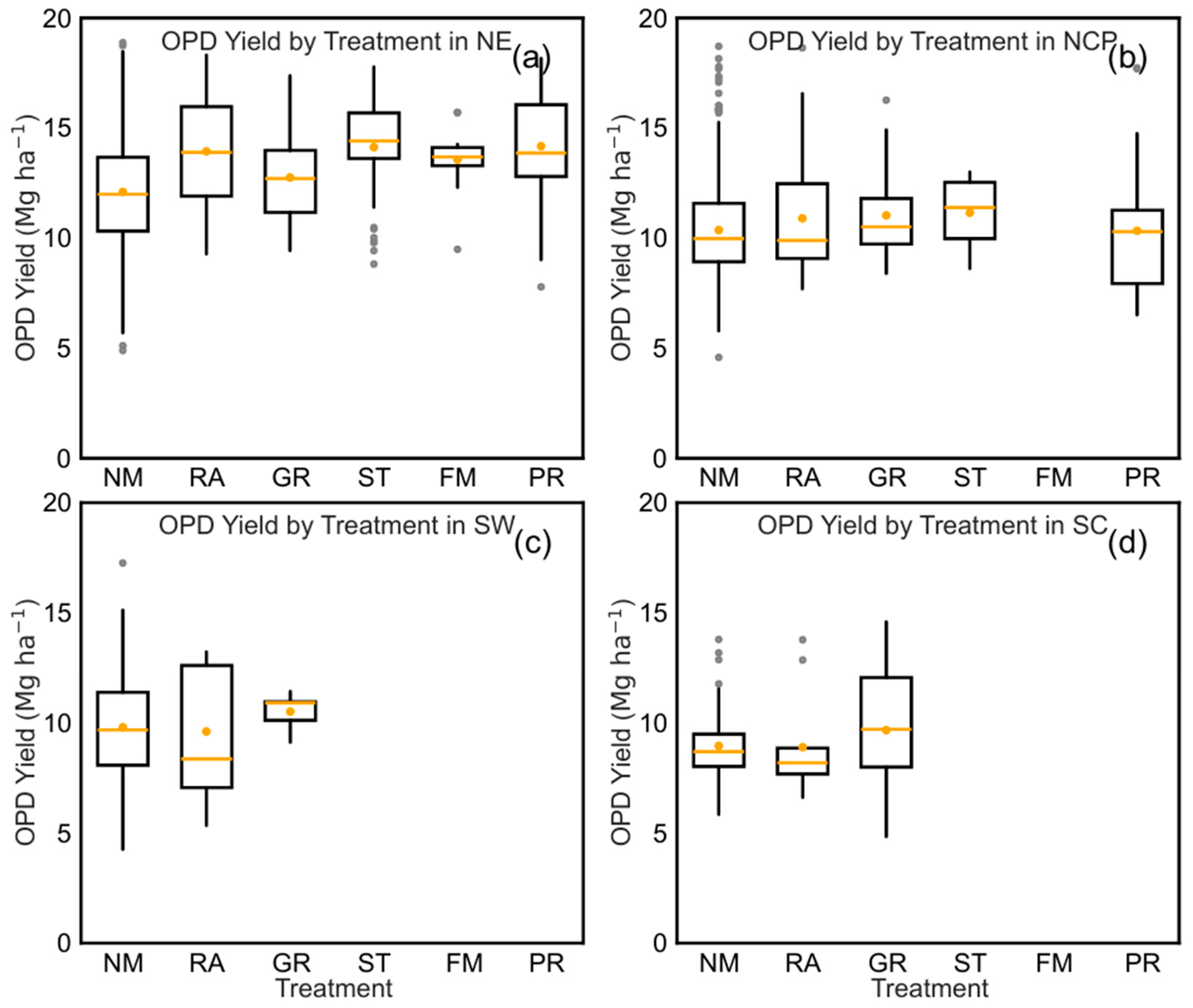
| Maize Planting Area | Study Sites of NM | Study Sites of AM | Study Sites of FP |
|---|---|---|---|
| NE | 714 | 245 | 244 |
| NCP | 607 | 156 | 225 |
| NW | 20 | 3 | 14 |
| SW | 120 | 25 | 15 |
| SC | 47 | 37 | 14 |
Disclaimer/Publisher’s Note: The statements, opinions and data contained in all publications are solely those of the individual author(s) and contributor(s) and not of MDPI and/or the editor(s). MDPI and/or the editor(s) disclaim responsibility for any injury to people or property resulting from any ideas, methods, instructions or products referred to in the content. |
© 2025 by the authors. Licensee MDPI, Basel, Switzerland. This article is an open access article distributed under the terms and conditions of the Creative Commons Attribution (CC BY) license (https://creativecommons.org/licenses/by/4.0/).
Share and Cite
Lei, R.; Wang, Y.; Zhou, J.; Xiang, H. Tap Maize Yield Productivity in China: A Meta-Analysis of Agronomic Measures and Planting Density Optimization. Agronomy 2025, 15, 861. https://doi.org/10.3390/agronomy15040861
Lei R, Wang Y, Zhou J, Xiang H. Tap Maize Yield Productivity in China: A Meta-Analysis of Agronomic Measures and Planting Density Optimization. Agronomy. 2025; 15(4):861. https://doi.org/10.3390/agronomy15040861
Chicago/Turabian StyleLei, Renqing, Yuan Wang, Jianmin Zhou, and Haitao Xiang. 2025. "Tap Maize Yield Productivity in China: A Meta-Analysis of Agronomic Measures and Planting Density Optimization" Agronomy 15, no. 4: 861. https://doi.org/10.3390/agronomy15040861
APA StyleLei, R., Wang, Y., Zhou, J., & Xiang, H. (2025). Tap Maize Yield Productivity in China: A Meta-Analysis of Agronomic Measures and Planting Density Optimization. Agronomy, 15(4), 861. https://doi.org/10.3390/agronomy15040861






